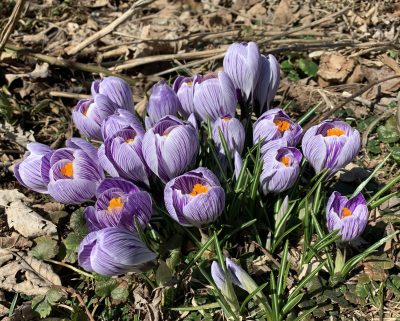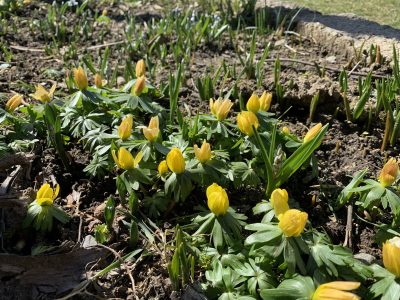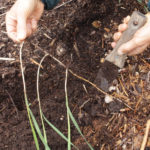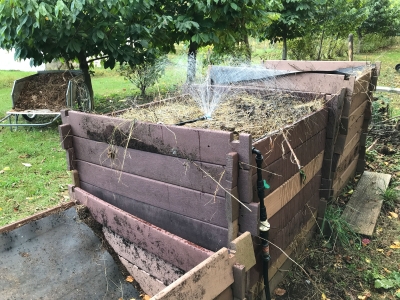NOW, WITH COVID-19, ANOTHER REASON TO GARDEN
Not Necessarily Anti-Social
I’m feeling very lucky these days, lucky to be happy to stay home. An important way to deal with the current COVID-19 pandemic, both from a personal and a societal standpoint, is not to be out and about.
(If you are infected, you may not show any symptoms for awhile, or symptoms may be very mild. During that time, though, you could infect others. It’s estimated that, at present, every infected person infects 3 others before they get well or die. Those 3 other each infect 3 more, and so on; ten transmissions has almost 60,000 people infected.
Social distancing brings that number of 3 new infections from each infected person down to a number of cases our health care system would be able to handle. So stay at home, if possible, maintain a six foot distance from other humans, be aware of contaminated objects and surfaces, and wash hands frequently.)
For all the downsides of the internet, a big plus now is the ability it gives us to interact socially without spreading disease.
Home is Nice, Gardening
What’s so great about staying home? In my case, I have my garden, of course. Spring, as always, is a busy time in the garden.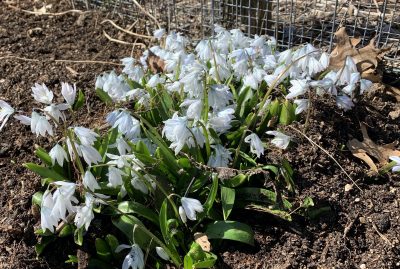 Busy, such as: attending to my compost. The last compost pile of late fall and winter is an accumulation of end-of-season debris from garden cleanup, bedding from the duck house, and kitchen scraps. Not much happens in it with the slow additions and winter cold. I decided to dig into the pile to see how it was doing. Not good!
Busy, such as: attending to my compost. The last compost pile of late fall and winter is an accumulation of end-of-season debris from garden cleanup, bedding from the duck house, and kitchen scraps. Not much happens in it with the slow additions and winter cold. I decided to dig into the pile to see how it was doing. Not good!
The innards were smelly and sodden, which could have been avoided if I had regularly thrown some straw, autumn leaves, or any other dry, old plant matter into it periodically. Oh well.
Given enough time, even that smelly, cold, sodden pile would turn to compost. I prefer to speed things up, getting the pile hot and quickly killing many weed seeds.
Aeration and some dry material could remedy the situation. I left home and got a load of horse manure mixed with dryish sawdust bedding from a nearby stable. (No human contact was needed to get the manure). Then I began turning the pile, layering in the manure and some old hay that I had cut and raked last fall. The way I tell how its doing is by taking its temperature with a long-stemmed compost thermometer. Three days after the turning, the pile is warming, 90° and rising.
Seed Starting, When?
Busy, such as: starting seedlings indoors for later planting outdoors. The ideal is to have seedlings the right size when it’s time for that outdoor planting, so they can make a smooth transition from container to ground hardly knowing they’ve been moved. Each vegetable has its own timetable for how fast it grows to transplant size and then when it can be planted outdoors.
For instance, here on the farmden, the historical average date of the last killing frost is May 21st. Cabbage seedlings need about 6 weeks of growth before they’re large enough to transplant. Since they tolerate some cold, they can be planted out here on May 1st. Six weeks before May 1st is March 15th, which is when I sowed those seeds.
Let me also use tomato as an example because that’s one that many gardeners plant too early or too late. Tomato seeds need about 7 weeks of growth before they’re ready to plant out. Freezing temperatures are not good for them, so I plant them out around the end of May. The end of May minus 7 weeks is around April 1st, which is when I’ll be sowing tomato seeds.
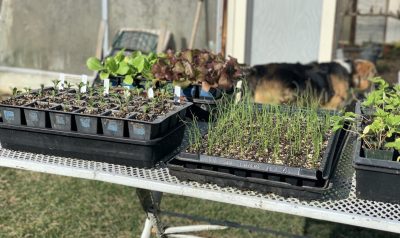
Sowing and planting dates are not set in stone. Temperature, potting mix, and container size all influence how fast seedlings grow. And there’s wiggle room because sowing or planting out tomatoes a week earlier or later doesn’t change the date of the first harvest that much because plants grow slowly early in the season.
One thing to avoid is being pushed around too much by the weather. Don’t let a 3 day warm spell in March convince you to sow tomatoes then, or a 3 day warm spell in early May to plant out tomatoes earlier. In the first case, the plant, being too large at transplant time, will have a harder transition to open ground; you’ll harvest earlier tomatoes, but less over the whole season. In the latter case, a subsequent cold spell might kill the plants (unless you cover them for protection).
I detail out recommended sowing and planting dates for vegetables according to locale in my book Weedless Gardening. At the very least, write down what you do in your garden this year and tweak it closer and closer each season.
Planting, What?
Busy, such as: planting out new trees, shrubs, and vines. After so many years here at the farmden, you’d think that I would have planted every tree, shrub, or vine I could have wanted. Tain’t so.
I’m very specific about what varieties I want to plant so I usually order bare root plants, which are available in greater variety than potted plants. Ideal size for a tree is about 4 feet high because their roots can establish in their new home quickly. Of course, a potted plant, if that variety is available locally, would establish even more quickly.
In the pipeline this year are Egremont Russet and Rubinette apples, Dr. Goode grape, Mohler persimmon, and a number of low bush blueberries and lingonberries.
I remember a sunny day years ago, right after hurricane Irene. The back part of my property, where my vegetable gardens are, was high and dry, a glorious early fall day. But turning 180 degrees, looking to the front, the Wallkill River and associated flood debris was flowing past my doorstep. These days, my thoughts are often on COVID-19. Again, the garden — or a hike in the woods and other home enjoyments — provide needed respite from a bad situation.
